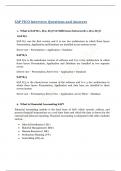Exam (elaborations)
SAP FICO Interview Questions and Answers
- Course
- Institution
SAP FICO Interview Questions and Answers 1. What is SAP R/1, R/2, R/3? Or Difference between R/1, R/2, R/3? SAP R/1 SAP R/1 was the first version and it is one tier architecture in which three layers Presentation, Application and Database are installed in one system/server Server one – ...
[Show more]



